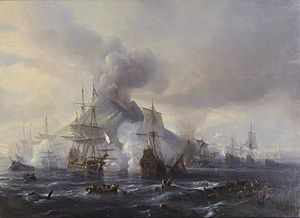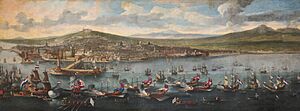Battle of Stromboli facts for kids
Quick facts for kids Battle of Stromboli |
|||||||
|---|---|---|---|---|---|---|---|
| Part of the Franco-Dutch War | |||||||
 Painting of the battle by Théodore Gudin |
|||||||
|
|||||||
| Belligerents | |||||||
| Commanders and leaders | |||||||
| Strength | |||||||
| 19 ships of the line or frigates 6 snows 5 fireships 1,200 guns |
20 ships of the line 6 fireships 1,500 guns |
||||||
| Casualties and losses | |||||||
| 1 ship of the line sunk | |||||||
The Battle of Stromboli, also known as the Battle of Alicudi, was a naval battle that happened on January 8, 1676. It was part of the Franco-Dutch War. The battle took place near the island of Stromboli in the Mediterranean Sea.
A French fleet of 20 ships, led by Abraham Duquesne, fought against a combined fleet of 19 ships. This allied fleet included 18 Dutch ships and one Spanish ship, all under the command of Lieutenant-Admiral-General Michiel de Ruyter. The battle lasted for eight hours and ended without a clear winner. The two fleets would meet again a few months later at the Battle of Augusta.
Contents
Why the Battle Happened
The Franco-Dutch War started in 1672 when France invaded the United Netherlands. France, led by King Louis XIV, wanted more land and power in Europe. The Dutch, along with Spain, were trying to stop France from becoming too strong.
In 1674, the city of Messina in Sicily rebelled against Spanish rule. Messina then asked France for help. France sent ships and soldiers to support Messina. This made Spain very unhappy.
Spain asked the Dutch for help. The famous Dutch admiral, Michiel de Ruyter, was sent to the Mediterranean Sea with a fleet of warships. His ships were not fully staffed because the Dutch were already busy fighting the war. De Ruyter waited for two months for supplies and Spanish ships to join him, but they were slow to arrive. He eventually sailed with only one Spanish ship added to his fleet.
Meanwhile, the French in Messina needed more supplies. Admiral Duquesne was sent to escort a convoy of supply ships to Messina. De Ruyter arrived in Sicily in early January 1676. He tried to attack Messina, but strong winds prevented him. On January 7, 1676, near the Lipari Islands, de Ruyter's fleet met Duquesne's French fleet and its convoy.
The Battle Begins
The French fleet's main goal was to get their supply convoy safely to Messina. They also wanted to keep their fleet strong. The Dutch wanted to stop the convoy and damage the French fleet as much as possible.
Both sides had a similar number of ships. However, the French fleet was more powerful. They had 1,500 guns compared to the Dutch and Spanish fleet's 1,200 guns.
On January 7, de Ruyter had the advantage of the wind, which is called the "weather gauge." This means his ships could control the attack. But he did not attack that day, or Duquesne managed to avoid him. During the night, the wind changed. It now favored the French.
The wind also got stronger. The Spanish galleys, which were smaller ships, had to find shelter near the Lipari Islands. Duquesne sent the supply convoy ahead and prepared to fight the Dutch.
Fighting at Sea
The battle started around 9 AM. Duquesne's ships sailed towards the Dutch fleet at an angle. This made it hard for them to fire all their guns. The Dutch ships, however, could fire all their guns in a "broadside" (firing all guns on one side of the ship at once).
De Ruyter's ships slowly moved away, keeping the French at a disadvantage. The first two French ships, Prudent and Parfait, were hit very hard by Dutch fire. They had to leave the battle line, which caused confusion among the French ships.
Even though Duquesne was wounded, he managed to get his ships back in order. He tried several times to break through the Dutch line of ships. But de Ruyter's ships stayed in a tight formation. Their heavy broadsides stopped the French attacks.
At the back of the French fleet, some ships crashed into each other. This made it hard for them to fight the Dutch ships at the rear. A gap appeared in the Dutch line, but the wind became very light. This meant the French could not use this gap to their advantage.
After about six hours of fighting, the ships were sailing side-by-side. Firing stopped at the front and middle of the fleets. But the ships at the very back kept fighting for a few more hours.
Three Dutch ships were badly damaged. Spanish galleys towed them to Milazzo. De Ruyter then took his entire fleet to Milazzo as well. He had successfully defended his smaller fleet, even though he was in a difficult position. He also caused significant damage to the French fleet.
After the Battle
Both sides had many ships that were badly damaged. The Dutch ship Essen sank the day after the battle. However, the Dutch had caused more damage to the French during their angled approach.
During the night, the wind picked up. Duquesne was joined by eight more French ships from Messina. The next day, the Spanish fleet was seen. Duquesne did not want to fight a larger force in the Strait of Messina while also protecting his convoy. So, he sailed his convoy all the way around Sicily. He successfully brought the supplies into Messina without any more fighting.
The combined Dutch and Spanish fleet sailed to Palermo for repairs. There were no major naval battles for several months after this.
Ships in the Battle
Here are some of the main ships that fought in the battle:
French Fleet (Duquesne)
Front Group (Avant-garde)
- Prudent (54 guns)
- Parfait (60 guns)
- Saint Michel (60 guns)
- Fier (48 guns)
- Mignon (46 guns)
- Assuré (56 guns)
Middle Group (Corps de bataille)
- Sage (54 guns)
- Syrène (46 guns)
- Pompeux (72 guns)
- Saint Esprit (72 guns) - Duquesne's ship
- Sceptre (80 guns)
- Éclatant (60 guns)
- Téméraire (54 guns)
- Aimable (56 guns)
Rear Group (Arriere-garde)
- Vaillant (54 guns)
- Apollon (52 guns)
- Grand (72 guns)
- Sans Pareil (70 guns)
- Aquilon (50 guns)
- Magnifique (72 guns)
Fireships
- 6 fireships (names unknown)
Dutch and Spanish Fleet (Michiel de Ruyter)
First Squadron
- Provincie van Utrecht (60 guns)
- Vrijheid (50 guns)
- Gouda (76 guns)
- Wakende Boei (46 guns)
- Edam (34 guns)
- Kraanvogel (46 guns)
- Rouaan (8 guns, a snow)
- Roos (8 guns, a snow)
- Sint Salvador (6 guns, a fireship)
- Zwarte Tas (4 guns, a fireship)
- Witte Tas (4 guns, a supply ship)
Second Squadron
- Steenbergen (68 guns)
- Leeuwen (50 guns)
- Eendracht (76 guns) - De Ruyter's ship
- Stad en Lande (54 guns)
- Zuiderhuis (46 guns)
- Leiden (36 guns)
- Tonijn (8 guns, a snow)
- Kreeft (8 guns, a snow)
- Salm (4 guns, a fireship)
- Melkmeisje (4 guns, a fireship)
Third Squadron
- Oosterwijk (60 guns)
- Harderwijk (46 guns)
- Spiegel (70 guns)
- Essen (50 guns) - Sank on January 9
- Damiaten (34 guns)
- Groenwijf (36 guns)
- Ter Goes (8 guns, a snow)
- Prinsen Wapen (8 guns, a snow)
- Jakob en Anna (4 guns, a fireship)
- Nuestra Señora del Rosario (50 guns, Spanish ship)
The combined fleet also had several Spanish galleys.


